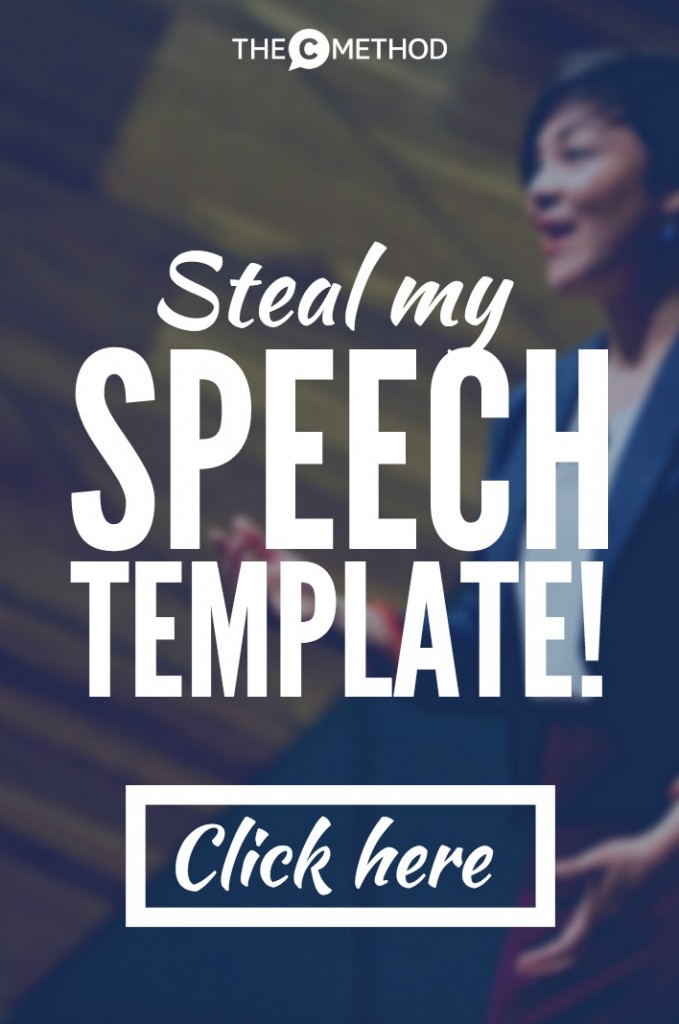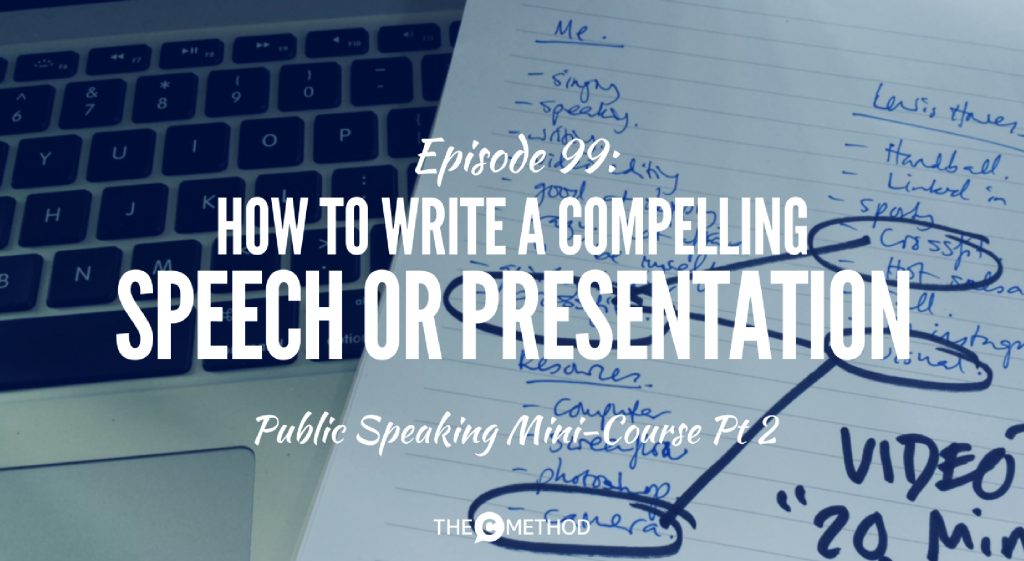Do you need to write an upcoming speech or presentation, but you don’t know where to start?
Maybe you’ve been asked to give a presentation at work, or you’ve put your hand up to speak, or the next client meeting is in your hands. In any case, congratulations! What an amazing opportunity to build your speaking skills and get noticed!
However, writing the presentation is often one of the trickiest things to do.
After all, you have SO much information to share — how do you pick what’s relevant? How do you grab the audience’s attention? And how do you structure it, oh — and remember the damn thing??
 In this podcast (and post), I share a clear framework for writing a presentation, so that you can feel less overwhelmed, more confident, and hopefully, inspired to do more speaking! (And FYI, this is the framework I use for my presentations, so it’s been well tested :))
In this podcast (and post), I share a clear framework for writing a presentation, so that you can feel less overwhelmed, more confident, and hopefully, inspired to do more speaking! (And FYI, this is the framework I use for my presentations, so it’s been well tested :))
I’ve based this framework on my Speech & Presentation Writing Template, which I use to help plan and write ALL my presentations.
And guess what?
I’ve made it available as a free download so you can use it too! I find this template extremely useful (well, that’s why I created it), so I highly recommend you use it.
This is Part 2 in the Public Speaking Mini Course. Click the links below to listen to Parts 1, 3 and 4.
- Part 1: How to plan your speech or presentation
- Part 3: How to overcome your fear of public speaking
- Part 4: Engaging Your Audience
- Want more? Register for the ‘Overcome Public Speaking Anxiety’ course
Steps to writing your presentation:
1. Start with an attention-grabbing opening, like a story, quote or fact.
The opening of your presentation is a HUGE opportunity to grab the audience’s attention. Many people fail here. They start with: “Uh, yeah, hi everyone, so…today we’re going to talk about…”
…and it’s SO BORING. I’ve already tuned out.
Instead, start with something punchy. For example, share the origin story of the project/topic (“I went to the aquarium last week, and discovered…”), a fact (“Did you know that 90% of the ocean’s fish population is depleted?”) or ask a question (“Who here has eating a piece of fish in the last week?”) and get a show of hands.
When writing your opening, keep this question at the front of your mind: How can I break people’s expectations of how a normal presentation begins?
Most people are used to BORING presentations and they will expect yours to be the same, so surprise them!
2. Share WHY this presentation is important.
Once you’ve grabbed your audience’s attention, you need to get them emotionally involved so they are more likely to connect with you and your ideas. And to do this, you need to show them WHY it’s important that they listen.
Remember, your audience will ALWAYS be thinking “So What? What’s in it for me?”
3. What RESULTS will your audience get from listening?
Notice we’re spending a fair bit of time with the lead up to the body of the presentation. This is important, because if you go straight into the ‘meat’ of your presentation and your audience doesn’t fully believe that they need to listen — they’re going to tune out pretty quickly!
So the next step is to share what your audience is going to walk away with. Are they going to have a better understanding of your topic? Are they going to be inspired to take action? Will you give them some simple how-to’s to practice?
Simply put: how is this presentation going to make their lives easier?
Again, it relates back to the ‘why’, and why they should care. If you can’t think of anything, you’d better get creative 😛
4. WHAT is this thing you’re talking about?
At this point, your audience understands WHY they need to listen, and the RESULTS they’ll get, they will be much more interested in listening. Aww yeah!
Now, you need to share with them WHAT the thing is you’re talking about. Here is where you can define key terms, or show them what your vision/idea looks like.
5. HOW do you do it?
The ‘how’ is the process, or the ‘meat’ of your presentation; the part where you give people actionable things to do or think about.
A lot of people make the mistake of diving straight into the ‘how’ of their presentation too early. The problem with this is if you haven’t given people a reason to CARE (ie the ‘why’), they’re not going to be interested in listening to the ‘how’!
To write the ‘how’ of your presentation, select 3-5 key points you want to make. If you’re having trouble picking what to share, I cover how to select your content in Episode 88: How to Plan Your Speech or Presentation.
Avoid making more than 5 points. You’re better off picking fewer points and having your audience remember them, rather than making so many they can’t absorb them.
For each point, think of a relevant story, fact or quote you can use to illustrate it. This is like a ‘mini opening’ for each point. Then, share a lesson or your call-to-action.
For example (sticking with the fish theme): “How can you still enjoy fish but not contribute to over fishing? Eat sardines. Did you know that sardines are one of the most fast-populating fish on the planet? This is important because it means they are a sustainable food source…”
6. “Yeah, but…”
There will always be people in the audience thinking: “Yeah well, that won’t work for me” or “But what if x happens? What if y happens?”
It’s important to address these people’s doubts (you could also call them ‘objections’) if you want to get them on board. Write down a list of what you think those doubters will be thinking, and come up with your response to those. Then pick one, and address it at the end of your presentation.
For example: “Some of you may be thinking ‘Yeah, but aren’t sardines smelly and bony?’ It’s ok, you can eat the bones, they are really good for you, and they are cheap! Even if you swap one can of tuna for a can of sardines, you’ll be doing your bit to save the world’s fish population.”
It’s also a good idea to prepare your responses to other “Yeah buts” to use when you’re answering Q&A.
7. Conclude with a bang!
You’re almost there! Now it’s time to create an impactful ending. After all, you’ve done all this hard work to engage your audience — don’t let it go to waste with a weak, floppy ending!
The worst endings include: “…and…yeah that’s it” or “…I guess that’s the end then! Thanks for listening!” or “…and that’s about all I have to say” or “In conclusion…”
(Seriously, if you’re about to conclude, your tone of voice should communicate that. You shouldn’t have to say “I’m about to finish now!”)
Here’s how I end my presentations:
- Remind them of your goal. Tie it back to how you started.
- Summarise briefly what you’ve talked about Try not to repeat everything word for word.
- Give your call to action. What should your audience do after listening? Sign up to something? Come and speak to you? Organise another meeting? Go to your website? Make this very clear.
- End with a punchy closing line. Preferably make it optimistic and uplifting so your audience walks away feeling energised!
Congratulations!
You’ve just written a kick-ass presentation! Now it’s time to put it all together and practice it. I’ll be sharing more about effective presentation delivery in an upcoming post. Until then, keep on rocking it!

Leave a Reply